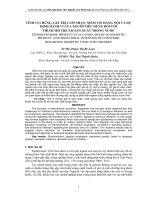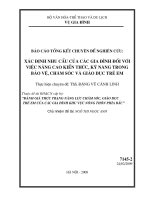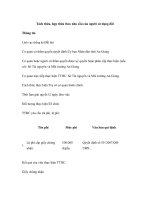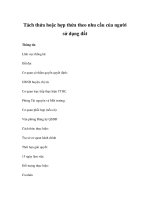Xác định nhu cầu của người tiêu dùng
Bạn đang xem bản rút gọn của tài liệu. Xem và tải ngay bản đầy đủ của tài liệu tại đây (529.42 KB, 21 trang )
Xác định nhu cầu của
người tiêu dùng
Dzung Hoang Nguyen
Teaching materials to accompany:
Product Design and Development
Chapter 4
Karl T. Ulrich and Steven D. Eppinger
Second Edition, McGraw-Hill, New York, 2000
Mục đích
Hiểu nhu cầu người tiêu dùng và truyền đạt
một cách hiệu quả cho nhóm phát triển.
Xây dựng một danh sách có cấu trúc các
tuyên bố về nhu cầu của người tiêu dùng.
Danh sách được tổ chức có thứ bậc theo
mức độ quan trọng của các nhu cầu.
Quy trình phát triển sản phẩm
tổng quát
Tiến trình phát triển concept
Tiến trình xác định nhu cầu ntd
Xác định mục tiêu
Thu thập dữ liệu thô
Quan sát
Phỏng vấn
Focus Groups
Giải thích kết quả
Trình bày các “nhu cầu”
Tổ chức các nhu cầu
Hệ thống có thứ bậc
Xác định mức độ quan trọng của các nhu cầu
Điều tra
Reflect on the process
Continuous Improvement
Tiến trình xác định nhu cầu ntd
Xác định mục tiêu
Thu thập dữ liệu thô
Quan sát
Phỏng vấn
Focus Groups
Giải thích kết quả
Trình bày các “nhu cầu”
Tổ chức các nhu cầu
Hệ thống có thứ bậc
Xác định mức độ quan trọng của các nhu cầu
Điều tra
Reflect on the process
Continuous Improvement
1.Xác định mục tiêu (ví dụ)
Mô tả sản phẩm
A hand-held, power-assisted device for installing threaded fasteners
Xác định các mục tiêu kinh doanh
Product introduced in fourth of 2008
50% gross margin
10% share of cordless screwdriver market by 2009
Becoming the recognized leader in usability
Thị trường chính
Do-it-yourselt consumer
Thị trường liên quan
Casual consumer
Light-duty professional
Một số giả định
Hand-held
Power-assisted
Nikel-metal-hydride rechargeable battery technology
Các đối tượng liên quan
User
Retailer
Sales force
Service center
Production
Legal department
2. Thu thập dữ liệu thô
Phỏng vấn: Một hay nhiều thành viên trong nhóm
trao đổi với một ntd. Điều tra được tổ chức trong môi
trường của người tiêu dùng và kéo dài trong khoảng
1-2h.
Focus groups: một người điều khiển một cuộc thảo
luận giữa 8-12 người tiêu dùng trong vòng 2h.
Quan sát: theo dõi hành vi sử dụng một sản phẩm
có sẵn của người tiêu dùng hay thực hiện một công
việc cho phép nảy sinh những nhu cầu của người
tiêu dùng trên một sản phẩm.
Thu thập dữ liệu thô
Written surveys ??????
Phỏng vấn hay điều tra nhóm
PHỎNG VẤN !
Số lượng người tham gia
Một ví dụ về thông tin hình ảnh : Một kiểu túi đựng sách
Phương pháp điều tra
Tiếp thu thông tin do người tiêu dùng cung cấp và
tránh hành động “phòng thủ” hoặc “đương đầu”.
Không thuyết phục ntd về những gì họ cần mà phải
thuyết phục ntd biểu đạt nhu cầu của họ.
Một số dạng câu hỏi:
When and why do you use this type of product?
What do you like about the existing products?
What do you dislike about the existing products?
What issues do you consider when purchasing the product?
What improvement would you make to the product?
Some general hints
Go with the flow
Use visual stimuli and props
Suppress preconceived hypotheses about
the product technology
Be alert for surprises and the expression of
latent needs
Watch for nonverbal information
3. Interpret Raw data
Express the need in term of what the product
has to do, not in term of how it might do it.
Express the need as specifically as the raw
data.
Use positive, not negative, phrasing.
Express the need as an attribute of the
product
Avoid “must” and “should”
5 hướng dẫn tổng hợp nhu cầu của
người tiêu dùng
Hướng dẫn
Nhận định của ntd Nhận định nhu cầu-Sai Nhận định nhu cầu-Đúng
What Not
How
Specificity
Positive
Not
Negative
Attribute
of the
Product
Avoid
“Must”
and
“Should
“Why don’t you put
protective shields around
the battery contacts?”
“I drop my screwdriver all
the time.”
“It doesn’t matter if it’s
raining, I still need to work
outside on Saturdays.”
“I’d like to charge my
battery from my cigarette
lighter.”
“I hate it when I don’t
know how much juice is
left in the batteries of my
cordless tools.”
The screwdriver battery
contacts are covered by
a plastic sliding door.
The screwdriver battery
is protected from
accidental shorting.
The screwdriver is
rugged.
The screwdriver
operates normally after
repeated dropping.
The screwdriver is not
disabled by the rain.
The screwdriver
operates normally in the
rain.
An automobile cigarette
lighter adapter can
charge the screwdriver
battery.
The screwdriver battery
can be charged from an
automobile cigarette
lighter.
The screwdriver should
provide an indication of
the energy level of the
battery.
The screwdriver
provides an indication
of the energy level of
the battery.
4. Organize the Needs in to Hierarchy
Print or write each need statement on a separate
card or self-stick note
Eliminate redundant statements
Group the cards according to the similarity of the
needs they express.
For each group, chose a label
Consider creating supergroups consisting of two to
five groups
Review and edit the organized needs statement
5. Establish the relative
importance of the needs
Relying on the consensus of the team
members based on their experience with
consumer
Basing the importance assessment on further
consumer survey
5. Establish the relative
importance of the needs
Cordless Screwdriver survey
For each of the following cordless screwdriver features, please indicate on a scale of
1 to 5 how important the feature is to you. Please use the following scale:
1. Feature is undesirable. I would not consider a product with this feature
2. Feature is not important, but I would not mind having it.
3. Feature would be nice to have, but is not necessary
4. Feature is highly desirable, but I would consider a product without it.
5. Feature is critical. I would not consider a product without this feature.
Also indicate by checking the box to the right if you feel that the feature is unique, exciting,
and/or unexpected.
Important of feature Check box if feature is unique
On scale of 1 to 5 exciting, and/or unexpected
____ The SD maintains power for several hours of heavy use
____ The SD can drive screws into hardwood
____ The SD speed can be controlled by the user while turning a screw
____ The SD has a pleasant sound when in use
…………………………………………….
Caveats
Capture “What, Not How”.
Meet customers in the use environment.
Collect visual, verbal, and textual data.
Props will stimulate consumer responses.
Interviews are more efficient than focus groups.
Interview all stakeholders and lead users.
Develop an organized list of need statements.
Look for latent needs.
Survey to quantify tradeoffs.
Make a video to communicate results.
Một thiết kế không tốt
There's coffee on your nose
This commuter mug has some nice features. It is well-insulated, so
the coffee really stays hot. Also, the cup fits into the cup holders in
the car.
It does have one fairly annoying feature though. There is a hinged
lid on top (shown in the open position) with a plug that seals the
hole that the coffee comes through. The plug (see arrow) on the
hinged lid has a small indentation in which a few drops of coffee
usually remain. When I tip the cup to drink from it, the plug touches
the bridge of my nose. The few drops of coffee in the indentation
run out and stick to my nose! My nose really isn't that big, either.
Design suggestion
I suspect that the designers of this cup are unaware of this problem
because they haven't observed people with different nose shapes
and sizes using this cup. It is important to test designs on a
representative sampling of potential users. There is a great deal of
truth in the old saying "People are all basically the same, but the
difference there is makes all the difference in the world!"









